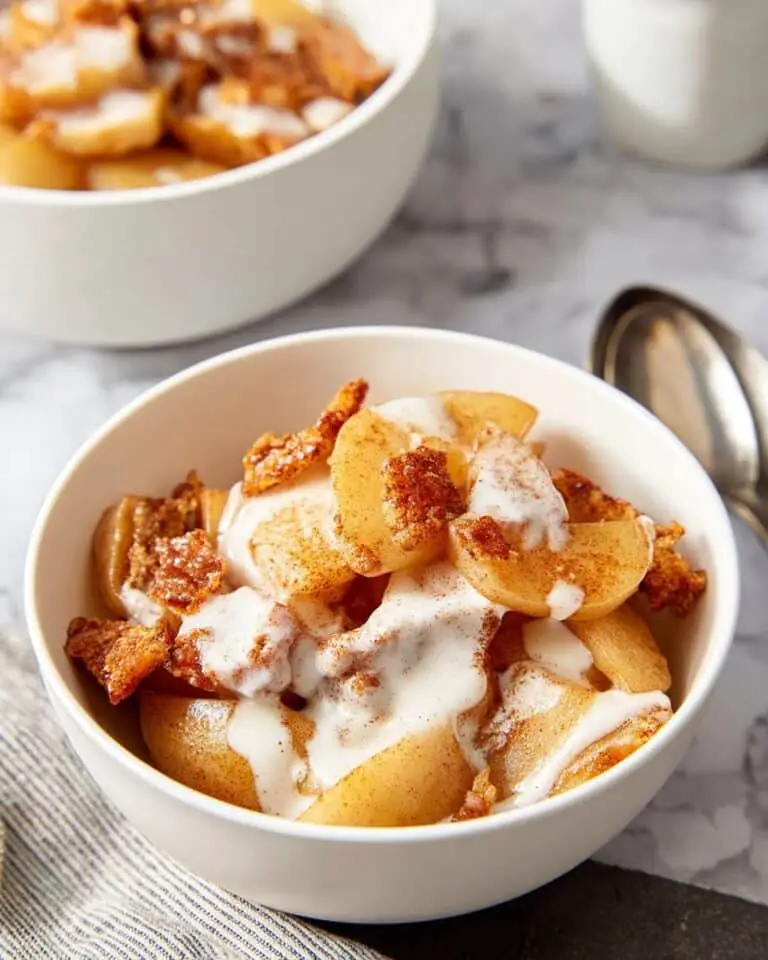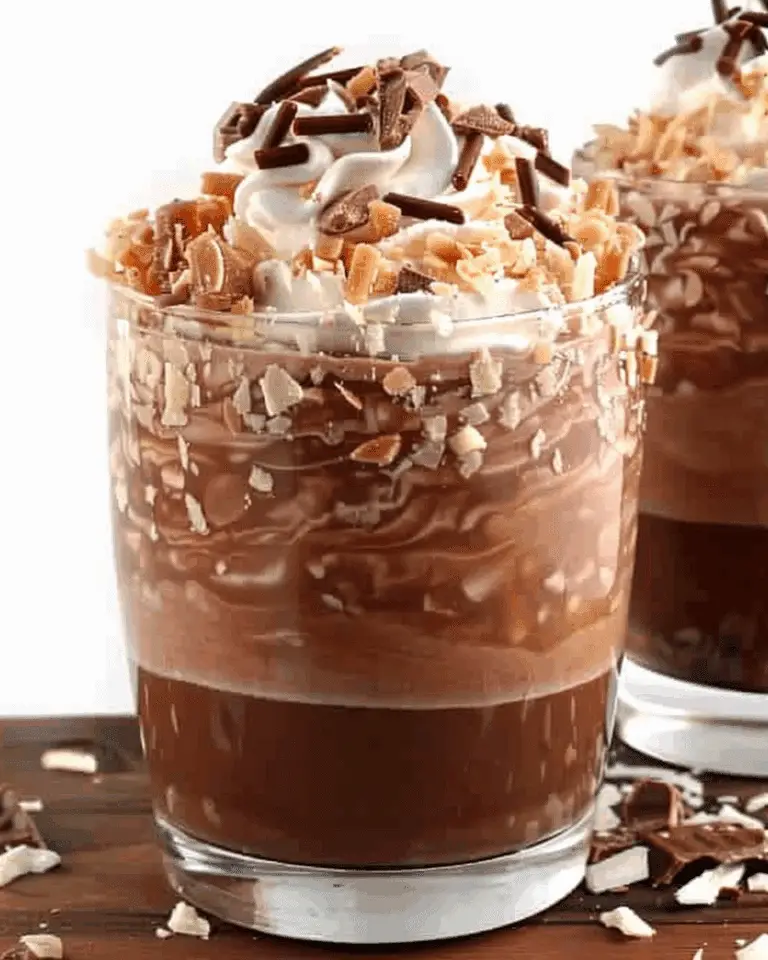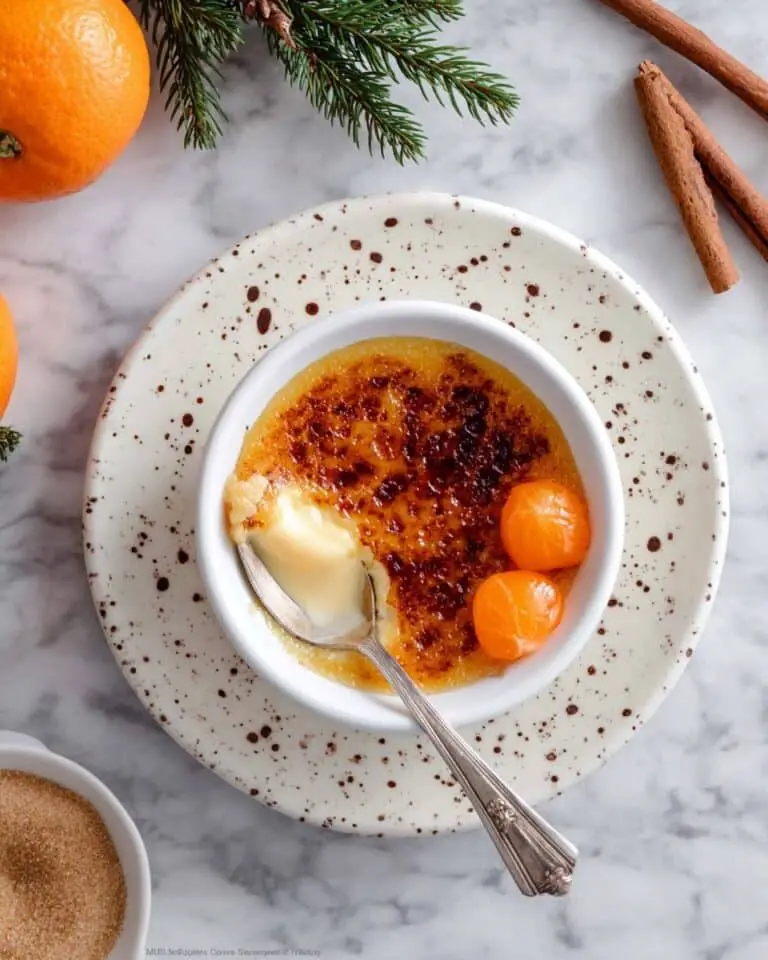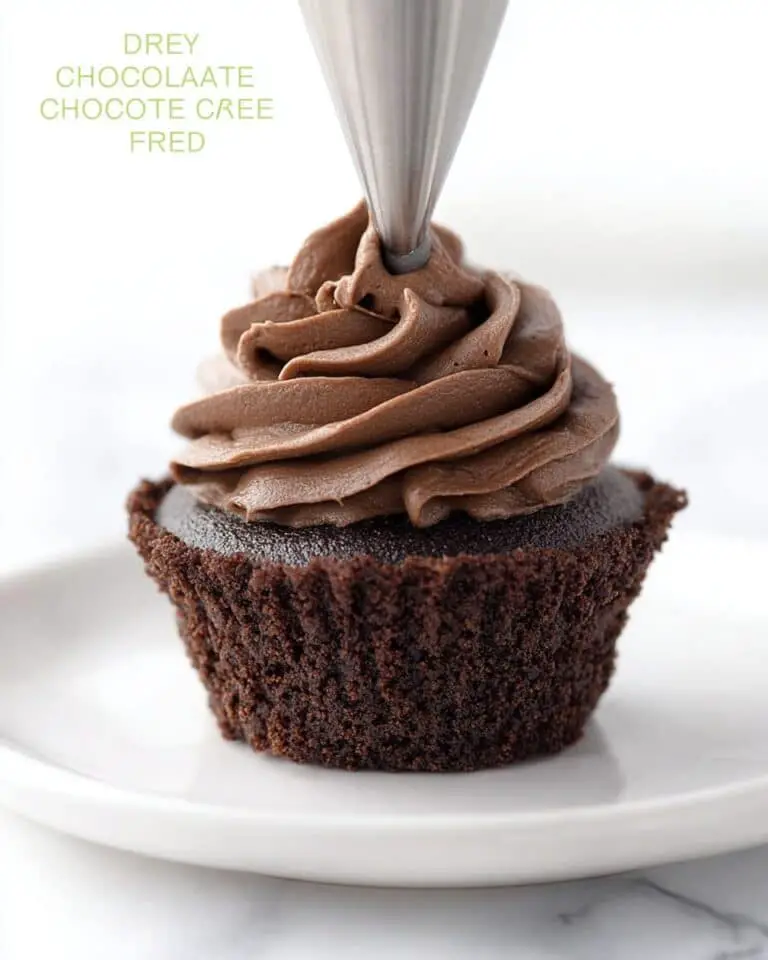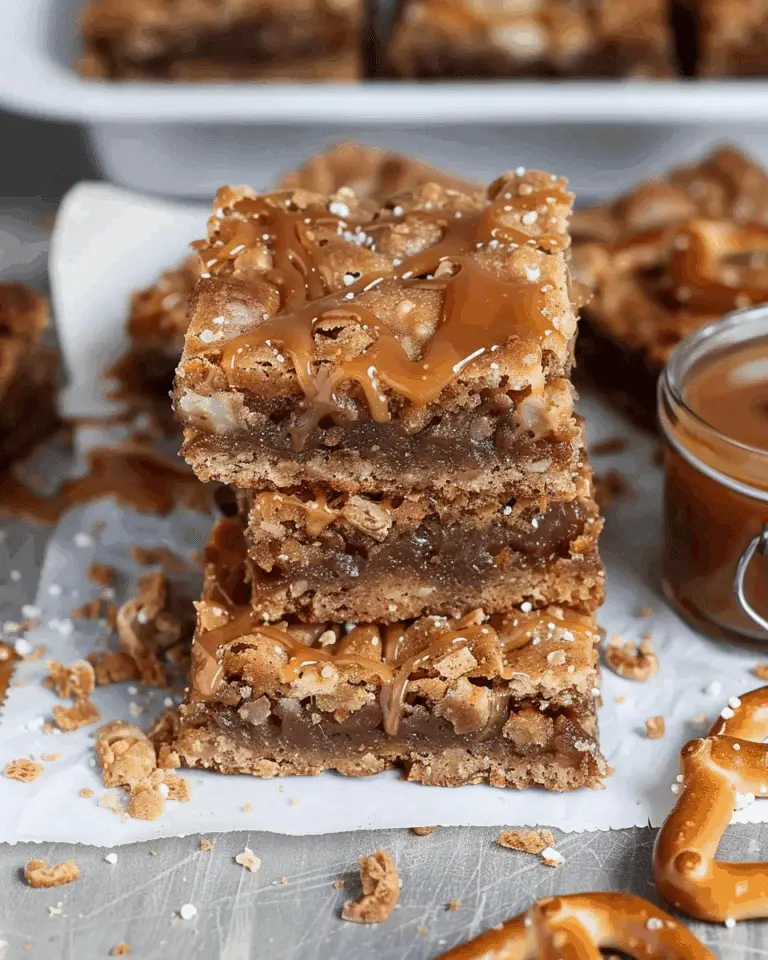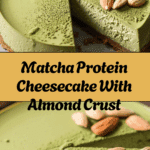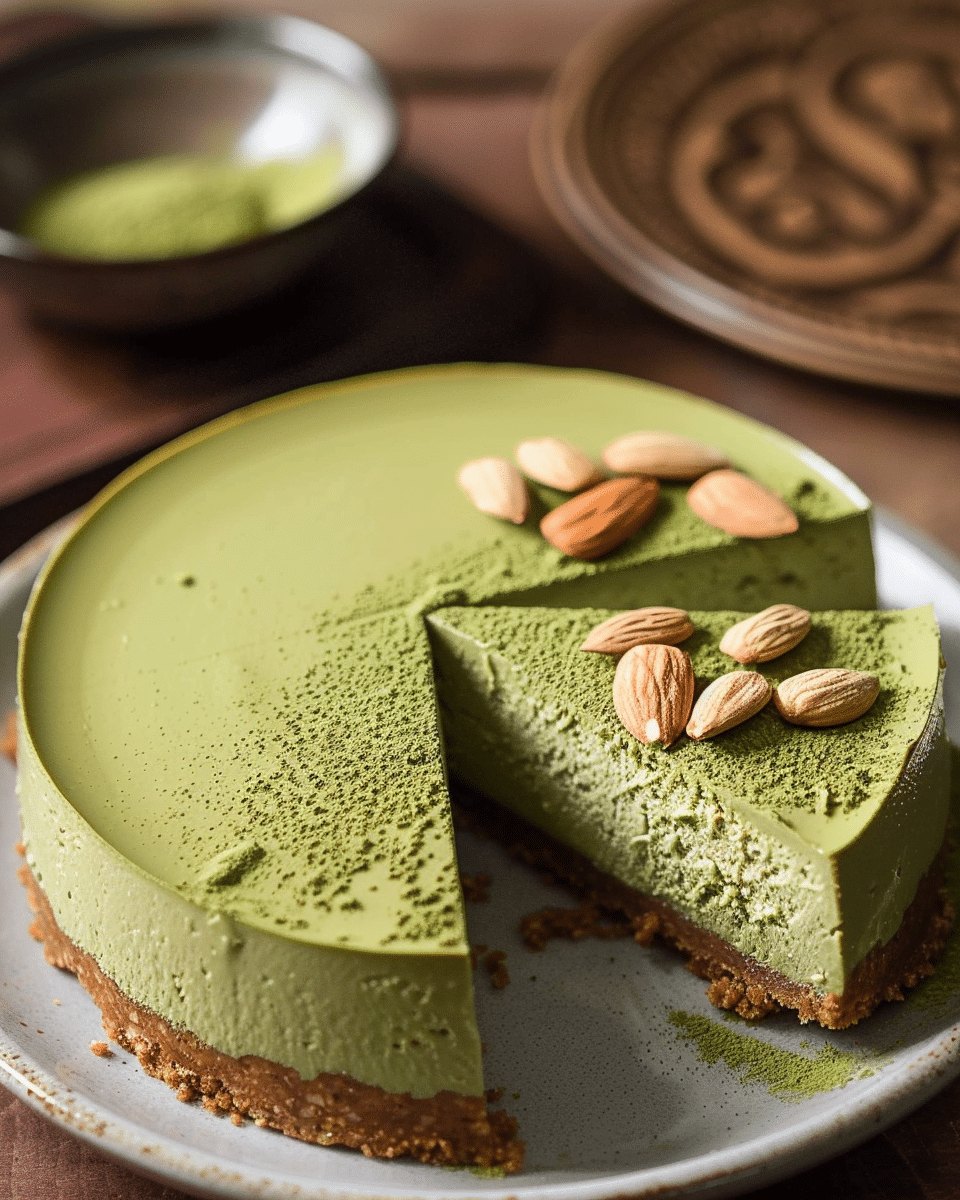
Why You’ll Love This Recipe
This Matcha Protein Cheesecake with Almond Crust is a delightful twist on traditional cheesecake. The vibrant green color from the matcha makes it visually striking, while the distinct, slightly grassy flavor of matcha pairs wonderfully with the creamy cheesecake filling. Adding protein powder not only boosts the nutrition but also helps to make this dessert more satisfying. The almond crust is both crunchy and rich, complementing the smooth texture of the cheesecake perfectly. Plus, it’s gluten-free and can easily be made dairy-free, making it a versatile treat for anyone with dietary restrictions.
Ingredients
For the almond crust:
- 1 1/2 cups almond flour
- 2 tablespoons maple syrup or honey
- 2 tablespoons melted coconut oil or butter
- 1/4 teaspoon vanilla extract
- A pinch of salt
For the cheesecake filling:
- 2 cups cream cheese (softened) or dairy-free cream cheese
- 1/2 cup plain Greek yogurt or dairy-free yogurt
- 1/4 cup vanilla protein powder (or plant-based protein powder)
- 1/4 cup maple syrup or honey (adjust for sweetness)
- 2 teaspoons matcha powder (adjust for intensity)
- 1 teaspoon vanilla extract
- 1/4 teaspoon salt
- 2 large eggs (or flax eggs for vegan)
(Tip: You’ll find the full list of ingredients and measurements in the recipe card below.)
Directions
- Prepare the crust:
- Preheat your oven to 350°F (175°C). Grease an 8-inch springform pan or line it with parchment paper.
- In a medium bowl, combine the almond flour, maple syrup or honey, melted coconut oil or butter, vanilla extract, and a pinch of salt.
- Mix until the ingredients are well combined and form a dough-like texture.
- Press the mixture into the bottom of the prepared springform pan, ensuring it’s evenly distributed.
- Bake for 8-10 minutes, or until the crust is golden brown. Set aside to cool.
- Prepare the cheesecake filling:
- In a large bowl or a stand mixer, beat together the softened cream cheese, Greek yogurt, and vanilla protein powder until smooth and creamy.
- Add the maple syrup or honey, matcha powder, vanilla extract, and salt. Continue to mix until fully incorporated.
- Beat in the eggs (or flax eggs) one at a time, mixing well after each addition.
- Pour the cheesecake filling over the cooled almond crust, spreading it evenly.
- Bake the cheesecake:
- Reduce the oven temperature to 325°F (163°C) and bake the cheesecake for 35-40 minutes, or until the center is set but still slightly jiggly. The edges should be lightly golden.
- Turn off the oven and allow the cheesecake to cool in the oven with the door slightly ajar for 1 hour. This helps prevent cracking.
- Chill and serve:
- After the cheesecake has cooled to room temperature, transfer it to the refrigerator and chill for at least 4 hours, or overnight, to fully set.
- Once chilled, remove from the springform pan, slice, and serve. You can garnish with additional matcha powder or fresh berries for extra flair.
Servings and Timing
- Servings: 8-10 slices
- Prep time: 15 minutes
- Bake time: 35-40 minutes
- Chill time: 4 hours (or overnight)
Variations
- Vegan version: To make this cheesecake vegan, substitute the cream cheese with a dairy-free version, use plant-based protein powder, and replace the eggs with flax eggs (1 tablespoon ground flaxseed mixed with 3 tablespoons water per egg).
- Sweetener alternatives: If you want a lower-sugar version, you can use stevia or monk fruit sweetener instead of maple syrup or honey.
- Crust variations: You can use crushed nuts or oats in place of almond flour for a different flavor or texture.
- Toppings: Top the cheesecake with fresh fruit like berries, a drizzle of honey, or a dusting of additional matcha powder for an extra layer of flavor and decoration.
Storage/Reheating
Store any leftover cheesecake in an airtight container in the refrigerator for up to 5 days. If you want to keep it for longer, you can freeze the cheesecake for up to 1 month. Allow it to thaw in the refrigerator overnight before serving.
FAQs
1. Can I use a different type of protein powder?
Yes, you can use any protein powder you prefer, such as whey, pea, or soy protein. Just ensure it complements the flavor of the cheesecake and matches your dietary preferences.
2. Can I make this recipe without the protein powder?
Yes, you can omit the protein powder, but it will reduce the protein content of the cheesecake. You may need to adjust the texture slightly by adding a little more yogurt or cream cheese to maintain the smoothness.
3. Can I use something other than almond flour for the crust?
Yes, you can use other gluten-free flours like coconut flour or oat flour, or even crushed gluten-free cookies for a different crust texture.
4. How do I know when the cheesecake is done baking?
The cheesecake is done when the edges are set, but the center still has a slight jiggle. It will firm up as it cools in the refrigerator.
5. How can I make the cheesecake more matcha-flavored?
If you want a stronger matcha flavor, you can increase the matcha powder to 2 1/2 teaspoons or more, depending on your taste preference.
6. Can I make this cheesecake in advance?
Yes, this cheesecake is perfect for making ahead. It requires a long chilling time, so it’s best to prepare it the day before you plan to serve it.
7. Can I make this cheesecake without a springform pan?
You can use a regular 8-inch round cake pan, but a springform pan makes it easier to remove the cheesecake once it’s chilled. If you use a regular pan, line the pan with parchment paper for easy removal.
8. Can I freeze this cheesecake?
Yes, you can freeze the cheesecake. Just wrap it tightly in plastic wrap and place it in an airtight container. Thaw it in the refrigerator overnight before serving.
9. Can I add a topping to the cheesecake?
Yes! You can top the cheesecake with whipped cream, fresh berries, a drizzle of honey, or a dusting of additional matcha powder for extra flavor.
10. Can I make a smaller version of this cheesecake?
Yes, you can reduce the ingredients and use a smaller pan (like a 6-inch round pan) to make a mini version of this cheesecake.
Conclusion
Matcha Protein Cheesecake with Almond Crust is a healthy yet indulgent dessert that offers the best of both worlds—flavor and nutrition. The creamy matcha filling, paired with the crunchy almond crust, makes each bite a delightful experience. With a boost of protein and the antioxidant power of matcha, this cheesecake is perfect for anyone looking for a nutritious treat that doesn’t compromise on taste. Whether you’re making it for a special occasion or just because, this cheesecake is sure to become a favorite!
Print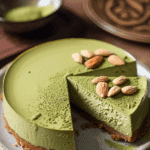
Matcha Protein Cheesecake With Almond Crust
- Total Time: 4 hours 15 minutes
- Yield: 8-10 slices
Description
Matcha Protein Cheesecake with Almond Crust combines creamy cheesecake with the earthy flavor of matcha and a protein boost. The almond crust adds crunch while keeping the recipe gluten-free, making this dessert both indulgent and nutritious.
Ingredients
- For the almond crust:
- 1 1/2 cups almond flour
- 2 tablespoons maple syrup or honey
- 2 tablespoons melted coconut oil or butter
- 1/4 teaspoon vanilla extract
- A pinch of salt
- For the cheesecake filling:
- 2 cups cream cheese (softened) or dairy-free cream cheese
- 1/2 cup plain Greek yogurt or dairy-free yogurt
- 1/4 cup vanilla protein powder (or plant-based protein powder)
- 1/4 cup maple syrup or honey (adjust for sweetness)
- 2 teaspoons matcha powder (adjust for intensity)
- 1 teaspoon vanilla extract
- 1/4 teaspoon salt
- 2 large eggs (or flax eggs for vegan)
Instructions
Prepare the crust: Preheat the oven to 350°F (175°C). Grease an 8-inch springform pan or line it with parchment paper. In a medium bowl, combine almond flour, maple syrup or honey, melted coconut oil or butter, vanilla extract, and a pinch of salt. Mix until the ingredients form a dough-like texture. Press the mixture into the bottom of the prepared pan. Bake for 8-10 minutes, or until golden brown. Set aside to cool.
- Prepare the cheesecake filling: In a large bowl or stand mixer, beat together the cream cheese, Greek yogurt, and protein powder until smooth and creamy. Add maple syrup or honey, matcha powder, vanilla extract, and salt. Beat until fully incorporated. Add eggs (or flax eggs) one at a time, mixing well after each addition. Pour the mixture over the cooled crust, spreading evenly.
- Bake the cheesecake: Reduce the oven temperature to 325°F (163°C). Bake the cheesecake for 35-40 minutes or until the edges are lightly golden and the center is set but still slightly jiggly. Turn off the oven and let the cheesecake cool in the oven with the door slightly ajar for 1 hour to prevent cracking.
- Chill and serve: After the cheesecake has cooled to room temperature, transfer it to the refrigerator and chill for at least 4 hours, or overnight. Once chilled, remove from the springform pan, slice, and serve. Optionally, garnish with matcha powder or fresh berries.
Notes
- Vegan version: Substitute dairy-free cream cheese, plant-based protein powder, and flax eggs for a vegan-friendly option.
- Sweetener alternatives: For a lower-sugar option, use stevia or monk fruit sweetener instead of maple syrup or honey.
- Crust variations: Swap almond flour for coconut flour, oat flour, or crushed gluten-free cookies for a different texture.
- Toppings: Top with fresh berries, whipped cream, or a drizzle of honey for extra flavor.
- Prep Time: 15 minutes
- Cook Time: 35-40 minutes
- Category: Dessert
- Method: Bake
- Cuisine: American
Nutrition
- Serving Size: 1 slice
- Calories: 240
- Sugar: 10g
- Sodium: 200mg
- Fat: 18g
- Saturated Fat: 6g
- Unsaturated Fat: 12g
- Trans Fat: 0g
- Carbohydrates: 14g
- Fiber: 4g
- Protein: 12g
- Cholesterol: 35mg


